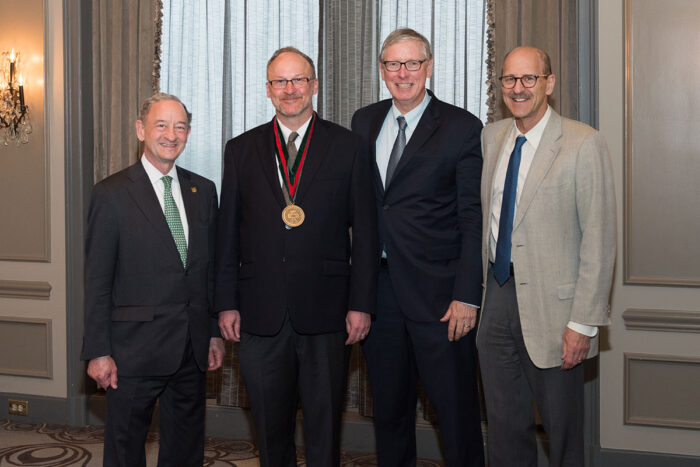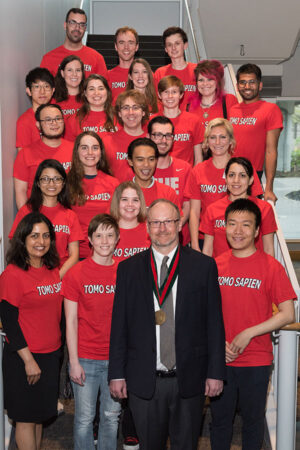Culver named Sherwood Moore Professor of Radiology
Recognized for using light to map the brain
 Mark Beaven
Mark BeavenJoseph P. Culver, PhD, has been named the inaugural Sherwood Moore Professor of Radiology at Washington University School of Medicine in St. Louis. Pictured are (from left): Chancellor Emeritus Mark S. Wrighton; Culver; Richard L. Wahl, MD, head of the Department of Radiology; and David H. Perlmutter, MD, the George and Carol Bauer Dean of the School of Medicine.
Joseph P. Culver, PhD, a professor of radiology recognized for helping develop optical neuroimaging technologies to map brain function in humans and animals, has been named the inaugural Sherwood Moore Professor of Radiology.
Based at the university’s Mallinckrodt Institute of Radiology (MIR), Culver’s lab is notable for advancing diffuse optical tomography (DOT), a technology that uses light from outside the head to track what the brain is doing. Optical imaging avoids the radiation exposure and bulky magnets other brain imaging technologies require. The approach is particularly useful for studying children and people with cochlear implants, pacemakers, deep brain stimulators and other implants that cannot be used safely in an MRI machine.
MIR funded and established the endowed chair to honor the legacy of Sherwood Moore, MD, the founding director of MIR. Moore served on the School of Medicine faculty from 1917 until his retirement in 1949. An expert on diseases of the gall bladder and bile ducts, he helped develop techniques for visualizing the gall bladder. Moore also collaborated with physics professor Arthur Hughes to build a cyclotron on the Danforth Campus to produce radioactive isotopes for medical use. During World War II, this accelerator produced plutonium for the Manhattan Project. Moore died in 1963.
Culver was installed as the Moore Professor by then-Chancellor Mark S. Wrighton and David H. Perlmutter, MD, executive vice chancellor for medical affairs, the George and Carol Bauer Dean of the School of Medicine, and the Spencer T. and Ann W. Olin Distinguished Professor of Medicine.
“This professorship is particularly special as it is one of three that the Department of Radiology created in honor of giants in the history of the department,” said Wrighton, now chancellor emeritus. “I am grateful to the Department of Radiology for establishing this professorship not only to honor its roots, but also to support remarkable faculty members such as Dr. Culver. He and his colleagues are pushing the boundaries of scientific discovery and its promise to advance human health.”
Also a professor of physics and of biomedical engineering, Culver has created a wearable cap that uses dozens of tiny LED lights to image what the brain is doing while people are engaged in a variety of activities. Since the system is portable, Culver has used it to study human behavior not only in the lab but also in babies in the newborn nursery, as well as brain function in children and adults in intensive care units.
In another project, his lab is developing ways of neuroimaging techniques to map blood and calcium dynamics for use in animal studies to help researchers identify changes in brain networks associated with neurologic disease.
“Joe Culver is a leader among his peers, and his impact on the imaging sciences and medicine is widespread and world-renowned,” said Perlmutter. “As the Sherwood Moore Professor of Radiology, Joe will take to new heights what already has been a remarkable body of work in developing neurophotonic technology for mapping brain function.”
Culver is co-director of Washington University’s Imaging Sciences Pathway and its Imaging Sciences PhD program, and has co-developed and taught several courses in the imaging sciences. He serves on the editorial board for the journal Neurophotonics and served on the board of directors of the Society for Functional Near Infrared Spectroscopy from 2010 to 2018.
“Professor Culver is an outstanding imaging scientist whose innovations have led to many important projects in brain imaging,” said Richard L. Wahl, MD, the Elizabeth E. Mallinckrodt Professor and head of the Department of Radiology and director of MIR. “He is also an outstanding educator and mentor. He is playing a major role in developing the next generation of imaging scientists.”
Culver earned his bachelor’s degree in math and physics in 1985 from Whitman College in Walla Walla, Wash., followed by a second bachelor’s degree in physics from the University of Washington, Seattle, in 1988. He earned his PhD in physics from the University of Pennsylvania in 1997 and joined the faculty at the School of Medicine in 2003.








